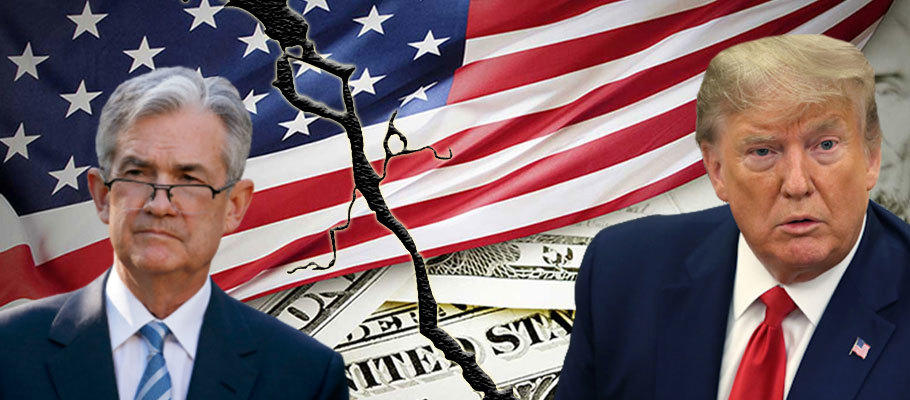
Published: June 17th, 2020
This past week ending June 12, the President of the U.S. Donald Trump and Jerome Powell, the Federal Reserve Chairman, two leading figures of the world’s leading economy, seemed to be at odds about the two critical aspects of life now; the rebound of both the economy and jobs.
In his original hard-hitting tweets, the U.S. President Donald Trump has criticized the Chief of the Federal Reserve, Jerome Powell. In the scathing tweet, President Trump castigated the Federal Reserve for what he termed as consistent incorrectness on the central bank’s part. The president said the bank’s prediction that 2021 will be a tough year is not accurate and that available data does not support this claim.
The Federal Reserve announced on Thursday, June 11, that it would use all tools it has to pull America out of the economic downturn caused by the global health pandemic. Signaling that it would keep the interest rate low throughout 2022, the central bank said the health crisis was causing untold human and economic suffering across the U.S. and the world.
In the bank’s semi-annual monetary report, Powell said the Federal Reserve is committed to supporting the American economy during these unprecedented times.
The report comes only two days after the bank’s policy meeting that kept the benchmark interest rate at 0.25%. The bank also promised to put billions of dollars in Treasury and securities-backed mortgages to sustain the financial markets.
The Federal Reserve’s June meeting ended with a statement that the financial markets consider as a bleak near-term assessment of the U.S. economy’s recovery.
The bank’s Open Market Committee members said the median outlook of the economy forecasts a GDP decline of 6.5% for 2020. The committee also advocates for zero interest rates for 2021 to 2022 as the economy staggers out of recession.
Though the forecast is gloomy, it paints 2021 and 2022 rosily with gains of 5% and 3.5%, respectively. These figures seem to agree with President Trump’s assertion that 2021 will be the best year for the American economy, which begs the question, why did the commander-in-chief reignite a war of words with the Federal Reserve chief?
It is the subdued economic forecast for next year that the president would instead do without. Citing the inconsistency of the central bank, Trump tweeted in part that the central bank is wrong. He said that he has access to the same data that the Federal Reserve used to arrive at its conclusion. The president said that the economic recovery would not wait for two years. According to him, the U.S. would have perfect Q3 and Q4, and overall, 2021 will be one of the best years. He even announced that the world would soon have a vaccine and cure for COVID-19.
The tweet marks the end of President Trump’s short-lived truce with the Federal Reserve. Just before the lull on attacks, Trump had accused the central bank of doing little to alleviate suffering. In particular, he had a problem with the interest rates accusing the central bank of keeping them so high and abruptly discontinuing the widest expansion the U.S. economy has ever seen.
The Federal Reserve has always resisted aggressive rate cuts that President Trump has been advocating. However, the coronavirus pandemic and its effects have convinced the bank to think and act otherwise.
Powell and his team have slashed the rates since mid-March putting the short-term benchmark interest rate near zero. Besides, the bank made an about-turn and started buying bonds and put in place programs seeking to keep the markets and the economy on toes.
The Fed's statement confirmed almost everyone’s anticipation that the interest rates would stay low for now until the economy shows firm signs of getting back from the doldrums.
President Trump’s attacks come as Powell prepares to testify before Congress. The Federal Reserve Chief appears before Congressional committees on Tuesday, June 16, and Wednesday, June 17, to explain the report to lawmakers.
It is expected that the veteran civil servant will answer the lawmaker’s concerns regarding where the central bank will source for resources to support the economy during the steepest economic dive in more than half a decade.
Fed officials expect unemployment to remain high at 9.3% through 2020 from a century-low of 3.5%. Powell said these figures reflect the general state of the economy. The Federal Reserve chair said he thinks that what the markets are seeing is a weak Q2, historically weak, and an economic expansion that will only build momentum over time.
These data points suggest a "U-shaped" recovery pattern where growth stops, the economy lumps, stagnates for two or three quarters before gaining steam again.
The Trump-Powell differences extended past the economy. While Trump was encouraged by the May employment report, Powell was soberer, choosing to remain faithful to the current situations. The president referred to the May jobs data as the most important news for equality and a win for George Floyd. Powell, on the other hand, gave a realistic lay of the land.
He said there is not enough reason to celebrate, considering that the economic downturn has not affected Americans equally. Powell noted that the segment of the population that is least able to bear the brunt of the misfortune is the most affected.
Powell noted that the increase in joblessness is especially acute among women, low-wage earners, African-Americans, and Hispanics.
President Trump and Federal Reserve Chair Jerome Powell took differing paths regarding the state of the U.S. economy. The Fed chair had earlier released a report highlighting that the GDP of the world’s leading economy will drop by 6.4% in 2020. These figures did not please the president who said that the Federal Reserve is consistently wrong and that the economy will bounce back faster than the central bank says it will.